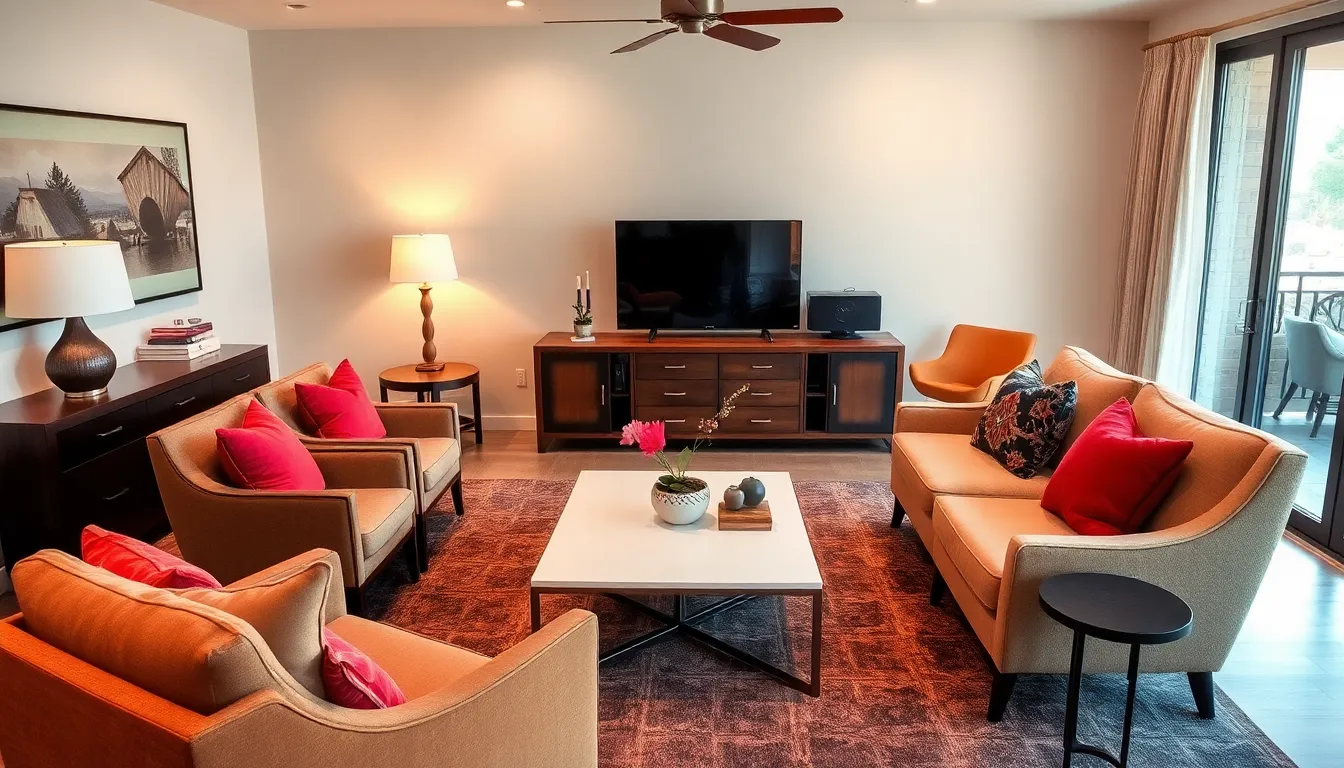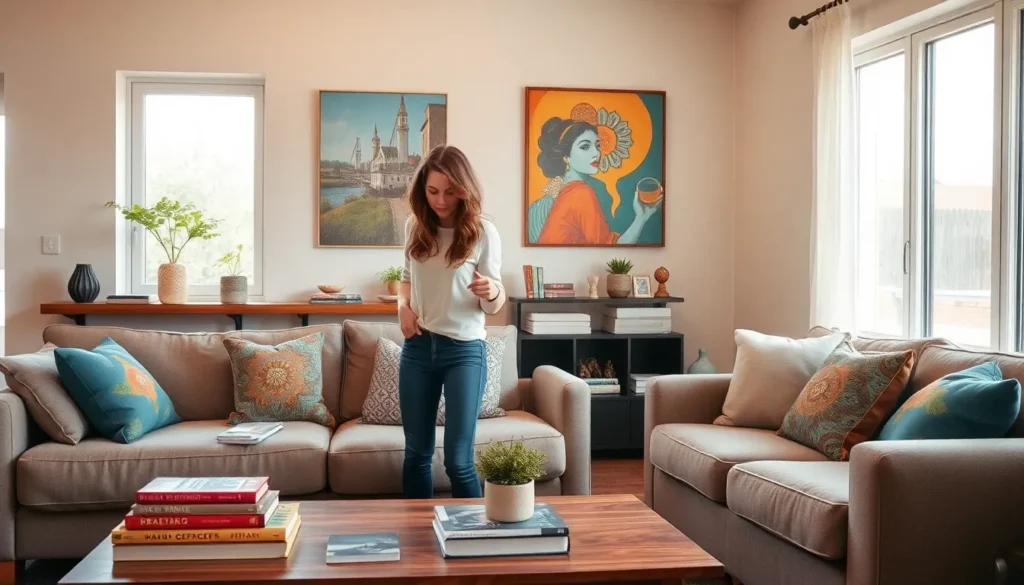Table of Contents
ToggleTransforming a living room into a stylish sanctuary doesn’t have to feel like a daunting task. With a sprinkle of creativity and a dash of flair, anyone can turn that bland space into a cozy haven that screams personality. After all, it’s the heart of the home where family gathers and friends spill secrets over coffee.
Understanding Your Space
Understanding the dimensions and features of a living room enhances its overall aesthetic. Both layout and color play critical roles in achieving a stylish look.
Assessing Living Room Layout
Assessing the living room layout creates functionality and flow. Start with measuring the room’s dimensions, including windows and doorways. Consider traffic patterns by placing furniture where movement remains unimpeded. Identify focal points, such as fireplaces or large windows, to guide arrangement decisions. Create zones for different activities, like lounging or entertaining. Finally, experiment with furniture placement using a floor plan or digital tools to visualize the setup.
Choosing the Right Color Palette
Choosing the right color palette sets the mood of the living room. Begin by selecting a main color that reflects personal style and complements existing elements. Consider incorporating a combination of neutral tones to provide a versatile backdrop. Add accent colors through decor and accessories for depth and interest. Utilize color psychology to evoke desired emotions, such as calmness or energy. Test samples on walls to assess lighting conditions and how colors interact throughout the day.
Furniture Selection

Selecting the right furniture makes a significant difference in a living room’s style and comfort. Prioritizing essential pieces creates an inviting atmosphere.
Key Furniture Pieces
Sofas serve as focal points in most living rooms. Choosing a comfortable couch invites relaxation and conversation. Accent chairs add additional seating while enhancing the overall look. A coffee table complements the seating area, providing a central space for drinks and decor. Media consoles serve practical functions, holding electronics while also contributing to the room’s style. Consider the scale of these key furniture pieces to ensure harmony in design.
Functionality vs. Aesthetics
Balancing functionality and aesthetics is crucial in achieving a stylish living room. Functionality addresses how well the furniture serves daily needs. Sofas should provide comfort for socializing or lounging. Aesthetic elements, like color and texture, contribute to the overall atmosphere. Designers often recommend thinking about how these elements interact, ensuring they work together seamlessly. Choose furniture that aligns with personal style while also catering to lifestyle requirements. Layout adjustments can enhance appearance and usability, creating a perfect sanctuary for gatherings.
Decor and Accents
Decor and accents add character to a living room, enhancing its overall appeal and inviting atmosphere. Thoughtful choices can create a cohesive design that reflects personal style.
Choosing the Right Textiles
Textiles play a crucial role in defining comfort and style. Rugs anchor the space, providing warmth and grounding furniture arrangements. Cushions introduce color and texture, inviting relaxation. Curtains frame windows and affect natural light, making rooms feel spacious or cozy. Fabrics like linen, cotton, or velvet contribute to the aesthetic, influencing the overall mood of the living room. Mixing patterns or sticking to a theme elevates visual interest. Selecting textures that enhance tactile experiences can also make the environment more inviting and enjoyable.
Incorporating Art and Accessories
Art and accessories reflect personal passions and can transform living rooms from ordinary to extraordinary. Wall art creates focal points and adds personality, while framed photographs evoke cherished memories. Decorative items such as vases or sculptures serve as conversation starters and complement the color palette. Layering accessories creates dimension and visual intrigue; a carefully curated coffee table can showcase unique finds. Plants introduce life and color, enhancing the room’s ambiance. The right combination of these elements can create a harmonious and stylish retreat catering to individual tastes and preferences.
Lighting Considerations
Lighting significantly influences the aesthetic and ambiance of a living room. Thoughtful design choices balance functionality and aesthetics while enhancing the overall comfort of the space.
Natural Light vs. Artificial Light
Natural light enhances the warmth and appeal of a living room, creating an inviting atmosphere. Large windows or strategically placed mirrors can increase sunlight exposure. Artificial light provides essential illumination when natural light diminishes. Use a mix of overhead fixtures, task lamps, and accent lighting to achieve balanced brightness. Consider using dimmable options to adjust intensity based on activities. Each type of lighting serves a specific purpose, helping create a versatile and welcoming environment.
Layering Your Lighting
Layered lighting is an effective strategy for achieving a well-lit living room. Combining ambient, task, and accent lighting creates depth and dimension. Ambient fixtures provide general illumination, while task lights focus on specific areas like reading nooks. Accent lighting highlights artwork or architectural features, adding visual interest. Consider the use of floor lamps, table lamps, and wall sconces for versatile options. Each layer contributes to a harmonious and inviting space, accommodating both relaxation and social gatherings.
Personal Touches
Personal touches enhance the living room’s character and make it uniquely inviting. Incorporating individual elements not only showcases personality but also creates a warm atmosphere.
Reflecting Your Style
Art pieces, photographs, and personal collections serve as great conversation starters. Displaying items that resonate with personal experiences adds depth. Vintage finds or eclectic decorations can express individuality. Arranging these elements harmoniously ensures a cohesive look while maintaining authenticity. Selecting colors or patterns that reflect personal preferences solidifies the living room’s identity. Each choice, from wall art to decorative objects, contributes to an inviting narrative that engages guests.
Incorporating Plants and Greenery
Plants introduce vitality and freshness to the living room. Choosing low-maintenance varieties like snake plants or pothos makes care easy while adding elegance. Greenery improves air quality, enhancing the environment significantly. Consider varying heights and sizes when arranging plants to create visual interest. Placing them near windows captures natural light, promoting healthy growth. Incorporating wall-mounted planters or stylish pots also attracts attention and showcases creativity. Ultimately, greenery enriches the room, bridging nature with design effortlessly.
Styling a living room is all about blending personal style with functionality. By understanding the space’s dimensions and thoughtfully arranging furniture, anyone can create an inviting atmosphere. Choosing the right color palette and incorporating textiles adds warmth and character, while layered lighting enhances the room’s ambiance.
Adding personal touches through decor and greenery not only showcases individuality but also elevates the overall design. With creativity and attention to detail, transforming a living room into a cozy sanctuary becomes an enjoyable and rewarding experience. Embrace the process and let the living room reflect personal taste and comfort.




